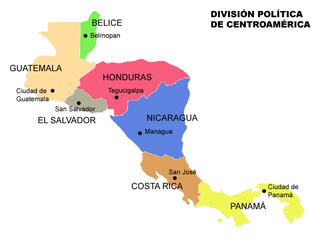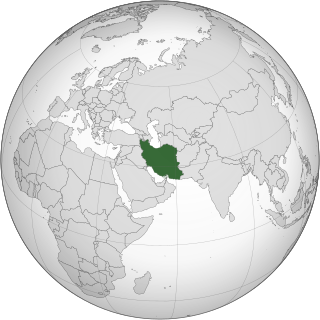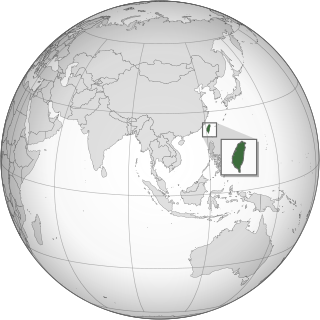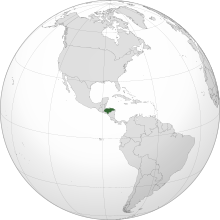
Squatting is the action of occupying an abandoned or unoccupied area of land or a building, usually residential, that the squatter does not own, rent or otherwise have lawful permission to use. The United Nations estimated in 2003 that there were one billion slum residents and squatters globally. Squatting occurs worldwide and tends to occur when people find empty buildings or land to occupy for housing. A variation is Street Squatting which is the action of occupying public areas without lawful permission, such as outdoor parks or streets. It has a long history, broken down by country below.

The Mosquito Coast is the area along the eastern coast of present-day Nicaragua and Honduras. It was named after the local Miskito Nation and was long dominated by British interests and known as the Mosquito Kingdom. From 1860 suzerainty of the area was transferred to Nicaragua with the name Mosquito Reserve, and in November 1894 the Mosquito Coast was militarily incorporated into Nicaragua. However, in 1960, the northern part was granted to Honduras by the International Court of Justice.

Roatán is an island in the Caribbean, about 65 kilometres (40 mi) off the northern coast of Honduras. It is located between the islands of Utila and Guanaja, and is the largest of the Bay Islands of Honduras. The island was formerly known in English as Ruatan and Rattan.

Central America is a subregion of the Americas formed by six Latin American countries and one (officially) Anglo-American country, Belize. As an isthmus it connects South America with the remainder of mainland North America, and comprises the following countries : Belize, Guatemala, Honduras, El Salvador, Nicaragua, Costa Rica, and Panama.

In England and Wales, squatting—taking possession of land or an empty house the squatter does not own—occurs for a variety of reasons which include needing a home, protest, poverty, and recreation. Many squats are residential; some are also opened as social centres. Land may be occupied by New Age travellers or treesitters.
Historically, squatting occurred in the United States during the California Gold Rush and when colonial European settlers established land rights. There was squatting during the Great Depression in Hoovervilles and also during World War II. Shanty towns returned to the US after the Great Recession (2007–2009) and in the 2010s, there were increasing numbers of people occupying foreclosed homes using fraudulent documents. In some cases, a squatter may be able to obtain ownership of property through adverse possession.

Afro-Nicaraguans are Nicaraguans of Sub-Saharan African descent. Five main distinct ethnic groups exist: The Creoles who descend from Anglo-Caribbean countries and many of whom still speak Nicaragua English Creole, the Miskito Sambus descendants of Spanish slaves and indigenous Central Americans who still speak Miskito and/or Miskito Coast Creole, the Garifunas descendants of Zambos expelled from St. Vincent who speak Garifuna, the Rama Cay zambos a subset of the Miskito who speak Rama Cay Creole, and the descendants of those enslaved by the Spanish.

Afro-Hondurans or Black Hondurans are Hondurans of Sub-Saharan African descent. Research by Henry Louis Gates and other sources regards their population to be around 1-2%. They descended from: enslaved Africans by the Spanish, as well as those who were enslaved from the West Indies and identify as Creole peoples, and the Garifuna who descend from exiled zambo Maroons from Saint Vincent. The Creole people were originally from Jamaica and other Caribbean islands, while the Garifuna people were originally from Saint Vincent and the Grenadines. Garifunas arrived in the late seventeen hundreds and the Creole peoples arrived during the eighteen hundreds. About 600,000 Hondurans are of Garífuna descent that are a mix of African and indigenous as of Afro Latin Americans. Honduras has one of the largest African community in Latin America.

Squatting in the Republic of Ireland is the occupation of unused land or derelict buildings without the permission of the owner. In the 1960s, the Dublin Housing Action Committee highlighted the housing crisis by squatting buildings. From the 1990s onwards there have been occasional political squats in Cork and Dublin such as Grangegorman, the Barricade Inn, the Bolt Hostel, Connolly Barracks, That Social Centre and James Connolly House.
Squatting is the occupation of unused or derelict buildings or land without the permission of the owner. From the 17th century onwards, there have been waves of squatting in Ukraine. In the 21st century, squatting has been practiced by different groups such as artists, anarchists, Ukrainian nationalists, displaced Crimean Tatars returning to the region and refugees created by the annexation of Crimea by the Russian Federation.

Squatting in Serbia refers to the unauthorised occupation of land or buildings. Following World War I, shanty towns emerged in the mostly demolished capital Belgrade, the most notable example being Jatagan Mala. The population of Belgrade rose from 593,000 in 1953 to 1,470,000 in 1981. Between 1961 and 1971, 52% of all private construction of houses in Belgrade was illegal. The percentage was also high in other cities such as Novi Sad and Smederevo. The reasons for squatting and illegal construction were the lack of affordable housing, bad governance and the bureaucracy involved in legalising land clams. Also the punishments were light.

Squatting in Namibia is the occupation of unused land or derelict buildings without the permission of the owner. European settlers arrived in the nineteenth century and acquired land, leaving only 38 per cent of land in indigenous hands by 1902. This led to squatting and the Herero Wars, which ended with the Herero and Namaqua genocide. After Namibian independence in 1990, squatting increased as people migrated to the cities and land reform became a goal for those who had participated in the liberation struggle. By 2020, 401,748 people were living in 113 informal settlements across the country. Squatting continues to be regulated by the Squatters Proclamation of 1985; a challenge to this law was dismissed by the High Court in 2023.

Squatting in the Republic of Vanuatu is the occupation of unused land or derelict buildings without the permission of the owner. After independence in 1980, informal settlements developed in cities such as Luganville and the capital Port Vila. Land in Vanuatu is either custom land owned by indigenous peoples or public land owned by the republic.

Squatting in Chile is the occupation of unused land or derelict buildings without the permission of the owner. From the 1960s onwards, informal settlements known as callampas were permitted although there were also evictions such as the massacre of Puerto Montt in 1969. In the 1970s, the government of Salvador Allende encouraged occupations, then following the coup d'état, the military junta repressed squatting. Callampas then became known as campamentos.

Squatting in Iran mostly occurs around the major cities, as rural migrants move to urban centres. From the 1950s onwards shanty towns have been set up and inhabitants are known as "koukhnishinan". Following the Iranian Revolution of 1979, squatter settlements increased, with the state sometimes evicting and sometimes legalizing the areas.

Urban areas in the Philippines such as Metro Manila, Metro Cebu, and Metro Davao have large informal settlements. The Philippine Statistics Authority defines a squatter, or alternatively "informal dwellers", as "One who settles on the land of another without title or right or without the owner's consent whether in urban or rural areas". Squatting is criminalized by the Urban Development and Housing Act of 1992, also known as the Lina Law. There have been various attempts to regularize squatter settlements, such as the Zonal Improvement Program and the Community Mortgage Program. In 2018, the Philippine Statistics Authority estimated that out of the country's population of about 106 million, 4.5 million were homeless.

Squatting in Liberia is one of three ways to access land, the other two being ownership by deed or customary ownership. The informal settlement West Point was founded in the capital Monrovia in the 1950s and is estimated to house between 29,500 and 75,000 people. During the First Liberian Civil War 1989–1997 and the Second Liberian Civil War 1999–2003, many people in Liberia were displaced and some ended up squatting in Monrovia. The Ducor Hotel fell into disrepair and was squatted, before being evicted in 2007. In the early 2020s, over 9,000 Burkinabés were squatting on remote land and the Liberia Land Authority (LLA) announced a plan to title all land in the country.

Squatting in Taiwan is the occupation of unused land or derelict buildings without the permission of the owner. Squatting was fuelled by migrants from China from the 1950s onwards and in addition cities such as the capital Taipei were swelled by internal migrants from the countryside. In order to create Daan Forest Park, 12,000 squatters were evicted. The informal settlement at Treasure Hill has been recognized as cultural heritage.

Squatting in Mexico has occurred on the periphery of Mexico City from the 19th century onwards. As of 2017, an estimated 25 per cent of Mexico's urban population lived in informal settlements. In Mexico City, there are self-managed social centres. The CORETT program aims to help squatters to register their land plots

During the colonial occupation of Kenya, Black Africans working on farms owned by white settlers were called "squatters" by the British. As of 1945, there were over 200,000 such squatters in the Highlands and more than half were Kikuyu. The Mau Mau rebellion began amongst these squatters in the late 1940s and after independence in the early 1960s, peasants started squatting land in rural areas without the permission of the owner.





















